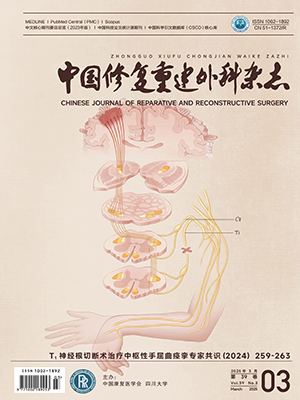Objective To explore the surgical feasibil ity and cl inical outcome of transpedicle screw fixation in treatment of atlantoaxial instabil ity and dislocation. Methods From January 2007 to June 2009, 16 patients with atlantoaxial
instabil ity and dislocation were treated with transpedicle screw fixation. There were 13 males and 3 females, with a mean age of 42 years (range, 24-61 years). The transpedicle screw fixation was employed in 5 patients with old odontoid fracture (4 of Anderson type II and 1 of type III), in 4 patients with fresh odontoid fracture, in 4 patients with traumatic disruption of transverse atlantal l igament, and in 3 patients with congenital odontoid disconnection for atlantoaxial instabil ity. All patients had symptoms of cervical pain and l imition of cervical motion, 10 patients compl icated by dyscinesia and hypoesthesia of extremities. The Japanese Orthopaedic Association (JOA) score before operation was from 5 to 13, with an average of 8.5. The image examination showed atlantoaxial instabil ity or dislocation in all patients. Granulated autogenous il ium (20-30 g) was placed onto the surface of the posterior arches of both atlas and axis in some patients with old fracture of odontoid process or disruption of transverse atlantal l igament. Results The mean operative time and bleeding amount were 1.6 hours (1.2-2.5 hours) and 100 mL (50-200 mL), respectively. All the incision healed by first intension. All patients were followed up for 3-18 months, with an average of 11.5 months.
The JOA score 3 months after operation was from 12 to 17, with an average of 14.2. All screws were successfully placed in atlas and axis. No postoperative compl ications such as vertebral artery injury, dural rupture, exacerbation of neurological symptoms, wound infection, and broken srews were observed in 16 cases. Postoperative radiograph and CT showed that only one screw penetrated into vertebral canal, but there was no neurological symptoms. Bony fusion was observed after 6 to 18 months of operation, and atlantoaxial rotational function in all patients restored satisfactorily, but axial rotation was partially lost. Conclusion Transpedicle screw fixation in upper cervical spine for treatment of atlantoaxial instabil ity and dislocation is safe and rel iable
Citation: QIN Wei,QUAN Zhengxue,OU Yunsheng,JIANG Dianming,LIU Yang,TANG Ke.. TRANSPEDICLE SCREW FIXATION IN UPPER CERVICAL SPINE FOR TREATING ATLANTOAXIAL INSTABILITY AND DISLOCATION. Chinese Journal of Reparative and Reconstructive Surgery, 2010, 24(2): 202-205. doi: Copy
Copyright © the editorial department of Chinese Journal of Reparative and Reconstructive Surgery of West China Medical Publisher. All rights reserved




